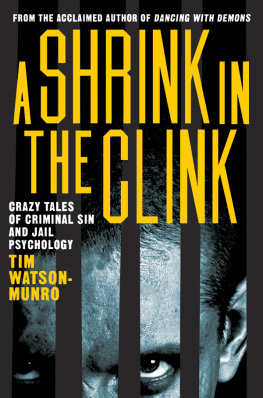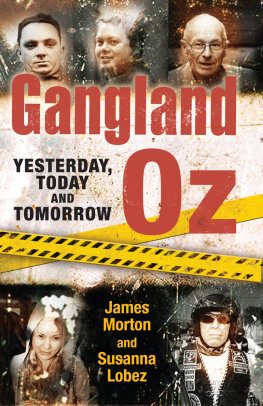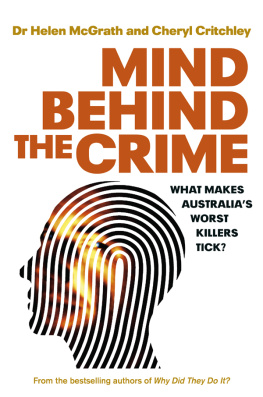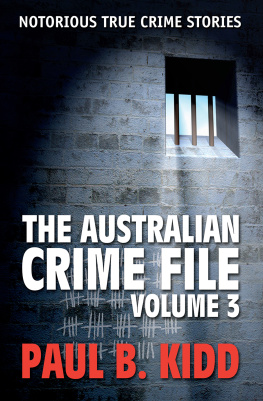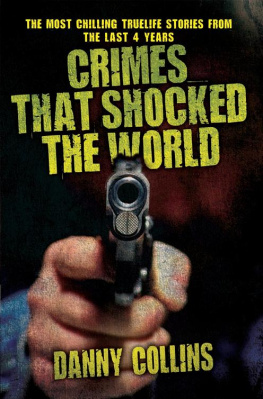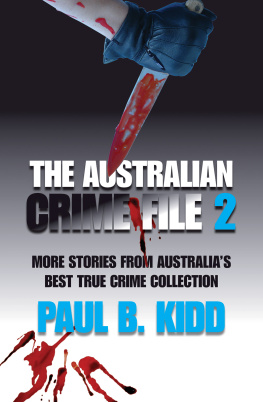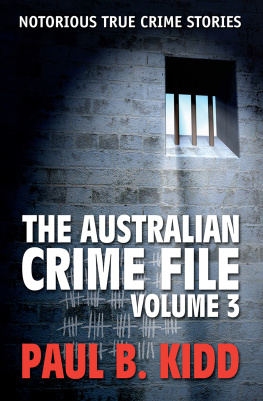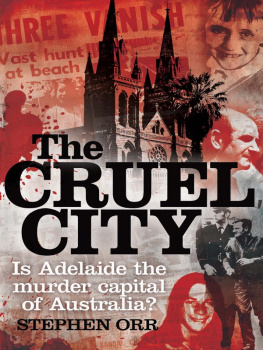Published by Brolga Publishing Pty Ltd
ABN 46 063 962 443
PO Box 12544, ABeckett St, VIC, 8006, Australia
email:
All rights reserved. No part of this publication may be reproduced, stored in a retrieval system or transmitted in any form or by any means electronic, mechanical, photocopying, recording or otherwise without prior permission from the publisher.
All efforts have been made to contact the copyright owners of images and any omissions will be corrected in future reprints.
Copyright 2011 Ian Ferguson
National Library of Australia CataloguinginPublication entry
Ferguson, Ian
Gangland crimes that shocked Australia
9781921596865 (pbk.)
9781925367331 (eBook)
Includes index, bibliography.
Organized crimeAustraliaHistory
Organized crimeAustraliaCase studies.
CriminalsAustraliaHistory
CriminalsAustraliaCase studies
Violent crimesAustraliaHistory.
Violent crimesAustraliaCase studies.
364.1060994
Cover by David Khan

This book is dedicated to
the victims of organised crime.
ACKNOWLEDGEMENTS
Once more I thank Ann, Belinda and Amy Ferguson for their ongoing enthusiastic support and much valued proof reading skills.
Ian Ferguson
CONTENTS
8. GANGLAND TERRORISTSTHE
HITMEN AND STANDOVER MERCHANTS
AUTHORS NOTES
A gang can broadly be defined as a group of individuals who work together for a common cause.
Often, such groups achieve excellent outcomes in work environments, when an enjoyable rapport exists between staff members, productivity are likely to be high. We applaud positive group motivation in team sports. An individuals selfless or courageous performance for the teams benefit, earns respect from the entire group, and greatly enhances the chances of success.
The desire to gain peer group acceptance is just as strong among individuals in criminal gangs, but while their actions may bring financial rewards to some perpetrators, negative effects occur in the community at large. The human toll from the activities of armed robbers, drug traffickers, standover bullies and terrorist fanatics, can never be justified.
Some media outlets and promotional agents appear to conveniently overlook the legacy of human misery that criminal gangs inflict on vulnerable members of the community. Currently, black limousine services are available to show curious onlookers precisely where victims of Melbournes gangland war were shot dead. There is always a ready book market for underworld identities to provide sanitised versions about their lives in crime. It is also rumoured that a range of Carlton Crew mens clothing will soon be launched.
Roberta Williams, the wife of Carl who may have murdered as many as ten people, is fast approaching celebrity status after making regular appearances on a TV current affairs program. The program glosses over the fact that Roberta herself recently served 18 months in jail for drug trafficking offences.
This book seeks to detail rather than glamourise the deeds of gangland identities and their associates. The authors sympathies lie very definitely with the innocent adults and children who suffer from callous underworld crimes, and the book is dedicated to the victims of organised crime.
The themes outlined here are extended regularly throughout the contents by a series of profilestitled The Victims. The overall statistics and real-life profiles contained in these sections, further remind us that unfortunate individuals often lose their self respect, their livelihood, the support of their family and friends and even their lives, while criminals satisfy their greed and lust for power.
Finally, both the first and last Victim profiles relate to the chilling new threat of international terrorist gangs. At the beginning of the 21st century, these profiles remind us of the grim reality that we are all at risk from the threat of terrorist attacks.
CHAPTER ONE:
CHANGING OF THE GUARD
Criminals will always exploit opportunities that society provides.
In the late nineteenth century, bushranger gangs ambushed gold escort teams on rough bush tracks in often isolated areas, and stole coveted metal that was being transported from the diggings. The robbers of colonial times exploited the advantages of surprise armed attacks on largely defenceless targets, to flee the scene quickly by horseback once the robberies were completed.
The first Australian armed bank robbery occurred in 1863 on the NSW central coast at Carcoa, which was then a wealthy grazing town close to a goldfields area. Fifteen years later the legendary Ned Kelly gang successfully robbed banks at Euroa and Jerilderie, but after the bushranger era ended, armed bank robberies became a relatively minor crime for nearly a century.
By the 1960s, however, gangs involving criminals such as Neddy Smith, Christopher Badness Binse and Victor Peirce, staged many armed bank and security van robberies in various suburbs of Sydney and Melbourne. It is interesting to note the key similarities and differences that prevailed, between gangs of the colonial past and their modern counterparts.

Ned Kelly
Preparation has been of paramount importance in every era. Both bushranger and recent modern gangs have carefully surveyed the locality of potential targets, before deciding whether or not to proceed with a robbery. Issues such as quick access to bank buildings, and safe departure routes from the crime scenes, are usually debated among gang groups. Within the Kelly gang, Ned and Joe Byrne would create a verbal strategy, after the agreed robbery site was carefully scrutinised. Byrne would then meticulously outline their final plan on paper.
Often the bank target chosen represented a compromise. The location needed to be sufficiently removed from their home territory, so that their raid would be unexpected. On the other hand, local assistance from the gangs supporters was valued, so Violet Town, Benalla, Seymour and Euroa became likely targets for these brigands from north-east Victoria.
Both bushranger and recent modern gangs carefully surveyed the locality of potential targets...
Once a decision was made, a safe house in the area was needed as a base. The venue needed to be large enough to hold any hostages the gang were forced to take during the course of the robbery. The Faithfuls Creek homestead proved an ideal location for the gang when they raided the Bank of New South Wales at nearby Euroa. Approximately 20 hostages were housed there before the bandits fled from the area.

Joe Byrne
Shortly before the robbery took place, the Kelly gang removed communication links from the immediate area. Telegraph lines were cut and insulators smashed, so back up forces could not quickly thwart their raid. In Euroa, a stolen spring cart and horses helped transport the stolen proceeds back to Faithfuls Creek.
Ned Kelly and Joe Byrne timed the Euroa robbery to perfection. A large funeral occupied local attention on that December day in 1878, so the pre-robbery activities of the gang attracted little attention. The timing of the raid also deliberately coincided with a full moon. Therefore after the gang abandoned their base at Faithfuls Creek under veil of night, they enjoyed maximum visibility when they returned on horseback to their north-east hideout.



